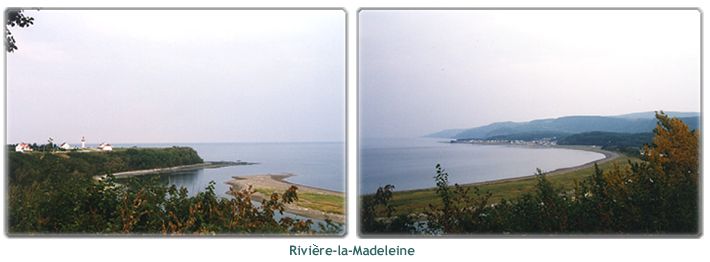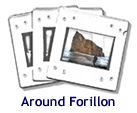![]() We
left Québec City and crossed the St. Lawrence River to get to its
southern shore. We drove Highway 20 as it paralleled the river, northeast
to Gaspé. It was a rainy, gray day. The St. Lawrence was a
river for a long while; the opposite shore was visible, as well as many
islands. One of these, Grosse Île, just north of Île d'Orleans,
was the Canadian gateway for immigrants from 1832 to 1937 — their
Ellis Island.
We
left Québec City and crossed the St. Lawrence River to get to its
southern shore. We drove Highway 20 as it paralleled the river, northeast
to Gaspé. It was a rainy, gray day. The St. Lawrence was a
river for a long while; the opposite shore was visible, as well as many
islands. One of these, Grosse Île, just north of Île d'Orleans,
was the Canadian gateway for immigrants from 1832 to 1937 — their
Ellis Island.
But at some
point — maybe accelerated by the misty conditions — the St.
Lawrence became something different. Diffused light was escaping through
the overcast, creating an effect quite surreal. Was I seeing across to
the other side, or was it my imagination, straining to find what I knew
should be there? An eerie, gray-blue-silver light saturated with salty
moisture hung over the sea — the Atlantic Ocean's masquerade
as a river was over. It was still, calm, immense. Here's a picture that
only partly captures what it was like somewhere north of Rimouski:
Click
for larger view
We passed through the windmill "farms" of Cap-Chat on the way to Ste-Anne-des-Monts, our destination that day. We had aimed to reach this town, which looked to be one of the larger in Gaspé. Well, that would turn out to be almost nonexistent — a large town in Gaspé, that is. We found a nice motel on the water, and a nearby restaurant (we were the only customers for a while) with more excellent food.
Peter played
golf in the morning on one of the few Gaspé courses, while I jogged
into town to get a closer look at its centerpiece: a massive Catholic
cathedral. It seemed every village in Gaspé, no matter how small,
had a stone church with one or two towering metallic spires (photo in
later installment). The labor that must have gone into building these!
As we left Ste-Anne-des-Monts, we stopped at the first of several lighthouses we'd visit on Gaspé. There's something about a lighthouse; they are irresistible. Each is unique — in design, setting, history, personality. The one at La Martre was up a steep drive just off the highway. Red, red, red. The light, the small house next door and the pickup truck that happened to be parked next to it. Red takes on a different intensity in misty weather.
The upper
Gaspé coast is characterized by the dramatic mountains and steep
cliffs that rise up (or slope down, depending on your point of view) right
next to the highway. (see Upper Gaspé slide show)  The
towns along this stretch — Riviere-à-Claude, Mont-St-Pierre,
Mont-Louis, and others — appear suddenly from around mountain bends.
They exist in the valleys that indent the mountains, with a quiet harbor
front, small, modest homes, and a huge church. Spectacular settings, each
town was protectively cupped from behind and aside by mountains; it was
hard to tell one from another.
The
towns along this stretch — Riviere-à-Claude, Mont-St-Pierre,
Mont-Louis, and others — appear suddenly from around mountain bends.
They exist in the valleys that indent the mountains, with a quiet harbor
front, small, modest homes, and a huge church. Spectacular settings, each
town was protectively cupped from behind and aside by mountains; it was
hard to tell one from another.
In Rivière-la-Madeleine, we turned left off the main highway toward another lighthouse that sat on a small cliff outcropping. This was about the northernmost point on the Gaspé peninsula. From here, we started to travel slightly south and still eastward into the next "region" referred to as Land's End.

In Grande-Vallée, one of the larger towns (pop. 1,430), we stopped at an historic (not-in-use) covered bridge; we also got "stuck" behind a school bus. It was kind of fascinating seeing these kids of different ages get on the same bus, around midday. It must be a simpler, saner place to grow up, here in this quiet, remote area. These were the only children we saw on the trip.
Further southeast on Highway 132 was a sign to Pointe-à-la-Renommée. We turned onto a dirt road and had a bumpy 5K drive to the coast. But well worth the trouble — a bonus stop. Here we got a well-travelled lighthouse and an historic site: the location of the first maritime radio station installed in North America. Mr. Marconi was at it again. There was a separate building with an exhibit on the 1904 station and Marconi — his life and work. Nicely done. The light itself was returned here, to its original location, in 1997 after a 20-year stay in the Port of Québec. We enjoyed the solitude (no other visitors); the sun broke through the mist and it was a beautiful place to be in the world.
Just before reaching Forillon National Park, we made yet another lighthouse stop, at the elegant Cap-des-Rosiers light. The tallest in Canada at 37 metres (112 feet), it was built in 1858. The firebrick walls are seven feet deep at the base and taper to three feet at the top.
Then into Forillon, a peninsula on a peninsula; it curves southward as it juts into the Atlantic. On the northern shore, at Cap-Bon-Ami we climbed down to a large rocky beach; great views of the limestone cliffs of the Cape to the south, and back north to the light we'd just visited. (see Around Forillon slide show)

Along Forillon's
south shore are some historic buildings in Grand-Grave. The Hyman &
Sons store is a restoration of a 1920s General Store, complete with canned
goods and Post Toasties.  Upstairs
was a "year in the life" exhibit of the hearty Gaspésians:
what they did for a living (fishing, cod preparation) during each season.
Upstairs
was a "year in the life" exhibit of the hearty Gaspésians:
what they did for a living (fishing, cod preparation) during each season.
From this vantage point we were looking across the Baie de Gaspé towards the town of Gaspé. The sun was low in the sky, dodging in and out of cloud cover and shimmering off the water. The only sandy beach around was at Penouille, where floodlit sunbeams fell on the landbars and enhanced the mountain silhouettes in the distance.
We completed
the ride around the Forillon peninsula and rounded the bend to head into
Gaspé to spend the night at a typical Quality Inn (with atypical
gourmet food). At the motel we met a retired professor from the Midwest.
He and his wife were on an eight-week sojourn across the east and south
of North America — quite an undertaking with just their car. We would
run into them not once or twice but three times in different places. Not
too unusual considering the scope of the area and the choices. It was
raining the following morning so we all ended up at the Musée de
Gaspésie learning more than we ever thought possible about Jacques
Cartier, who claimed this land for the King of France in 1534.
Galleries
...
Québec — Gaspésie
— Percé 1 — Percé
2 — Percé 3
© 2001 CCarnovale Home | Web Design | Graphics | Photos | Travels | At Home
